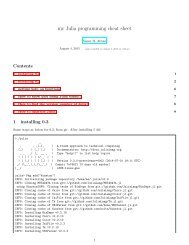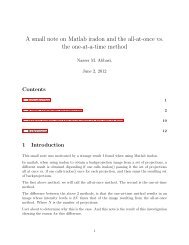You also want an ePaper? Increase the reach of your titles
YUMPU automatically turns print PDFs into web optimized ePapers that Google loves.
magnitude of ⃗r<br />
period T<br />
mean satellite speed n<br />
r = a ( 1 − e 2)<br />
1 + e cos θ = h2 1<br />
µ 1 + e cos θ<br />
r cos θ = a (cos E − e)<br />
r = a (1 − e cos E)<br />
√<br />
T = 2 h πab = 2π a 3<br />
µ<br />
n = 2π<br />
T = √<br />
µ<br />
a 3<br />
eccentric anomaly E tan θ 2 = √<br />
1+e<br />
1−e tan E 2<br />
area sweep rate<br />
dA<br />
dt = h 2<br />
equation of motion ¨⃗r +<br />
µ<br />
r 3 ⃗r = 0<br />
(eq 4.2-14 Bate book)<br />
spherical coordinates relation cos(i) = sin(A z ) cos(φ) where i is the inclination<br />
and A z is the azimuth and φ is latitude<br />
2<br />
Notice in the above, that the period T of satellite depends only on a (for same µ)<br />
In the above, µ = GM where M is the mass of the body at the focus of the ellipse and G is the gravitational<br />
constant. h is the specific mass angular momentum (moment of linear momentum) of the satellite. Hence the<br />
units of h2<br />
µ<br />
is length.<br />
To draw the locus of the satellite (the small body moving around the ellipse, all what we need is the<br />
eccentricity e and a, the major axes length. Then by changing the angle θ the path of the satellite is drawn. I<br />
have a demo on this here<br />
See http://nssdc.gsfc.nasa.gov/planetary/fact<strong>sheet</strong>/earthfact.html for earth facts<br />
This table below is from my class EMA 550 handouts (astrodynamics, spring 2014)<br />
2 Image is from my class notes, page 7-9, EMA 550, Univ. Of Wisconsin, Madison by professor S. Sandrik<br />
67





